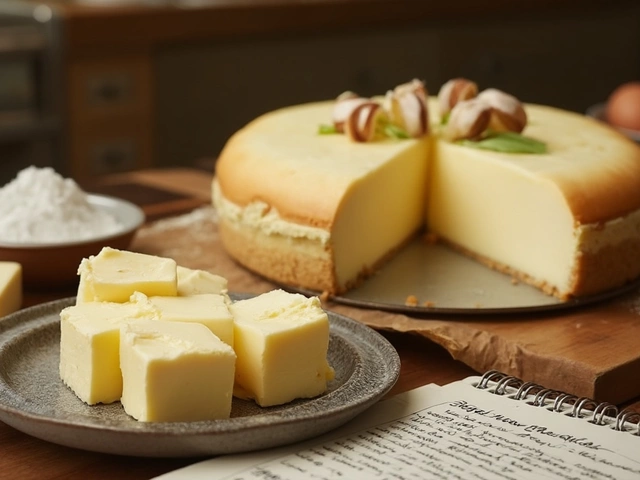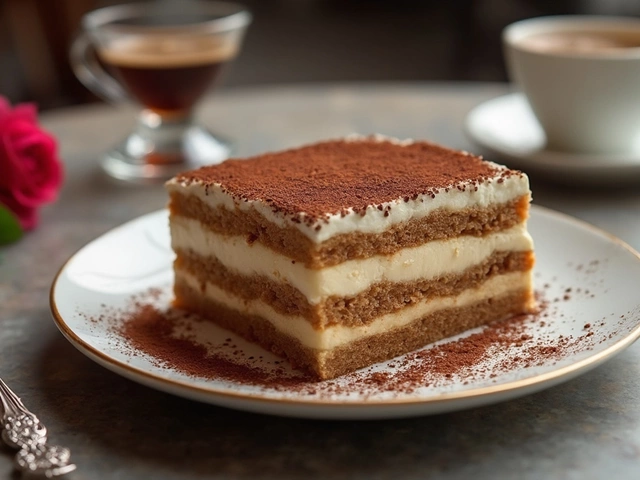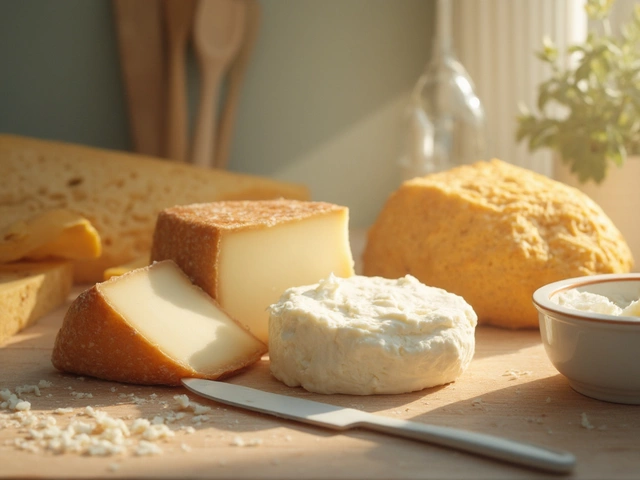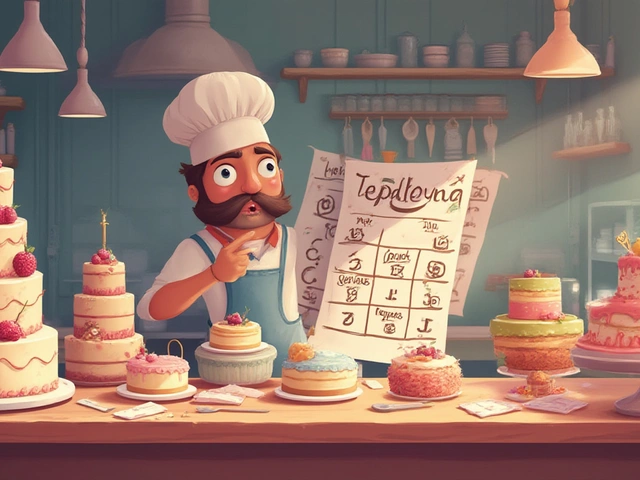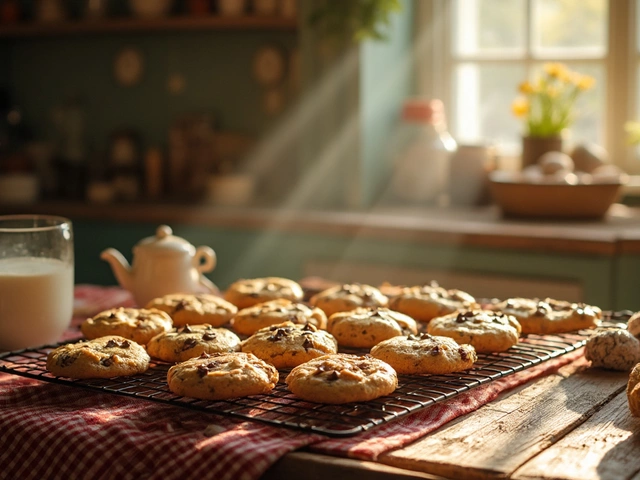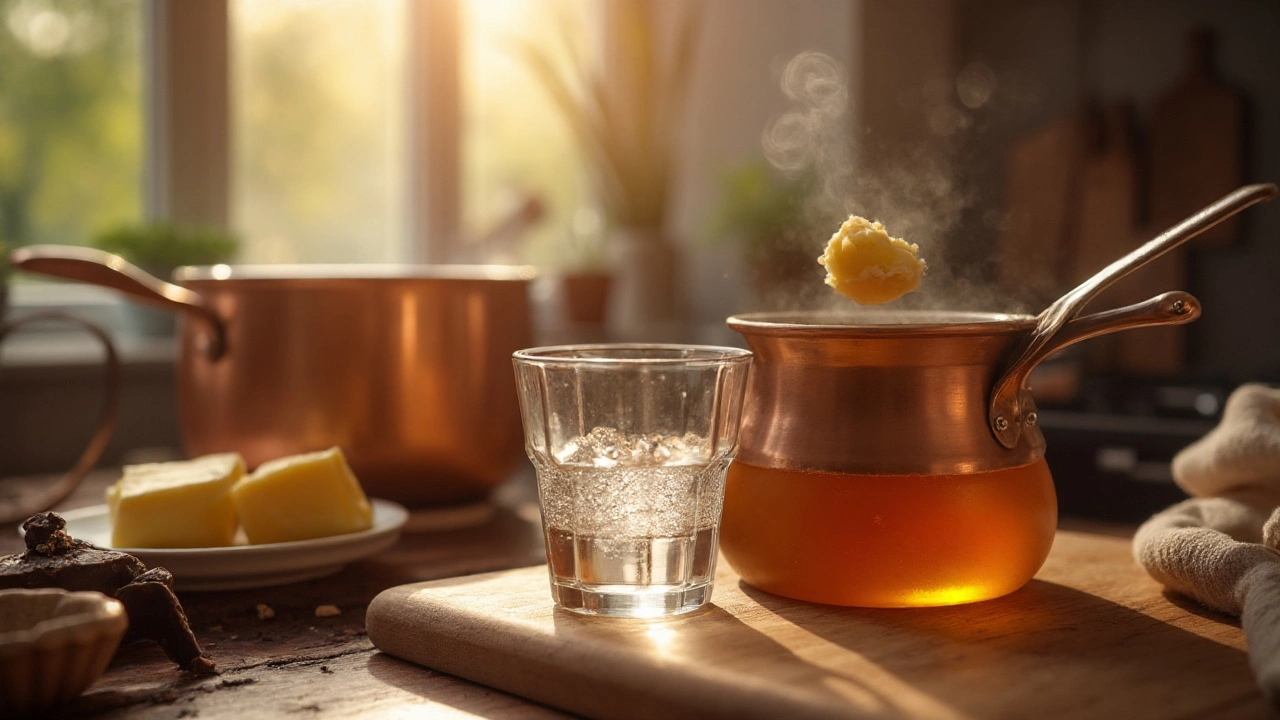
Most fudge fails come down to one thing: the final temperature. Hit the sweet spot and you get a creamy, sliceable slab. Miss by a few degrees and it turns grainy, runny, or rock hard. Here’s the exact temperature you need-and how to reach it with or without a thermometer.
TL;DR: Exact Temperature and Fast Facts
- Cook traditional (old-fashioned) fudge to 234-240°F (112-116°C). Many pros aim for 237°F (114°C).
- Lower end (234-236°F / 112-113°C) = softer fudge. Higher end (238-240°F / 114-116°C) = firmer fudge.
- Altitude matters: find your local boiling point of water, then subtract the difference from 212°F (100°C) to adjust your target.
- No thermometer? Use the cold-water test: drop a little syrup into cold water. It should form a soft, pliable ball that flattens when pressed.
- Let the fudge cool undisturbed to about 110-120°F (43-49°C) before beating. Stop beating when it loses gloss and thickens.
Step-by-Step: Hit Soft‑Ball Stage Without Guesswork
Here’s the simplest way to control texture and get that classic creamy crumb.
fudge temperature is not a suggestion; it’s the control knob for texture. Old-fashioned fudge is a sugar syrup that you cook to soft-ball stage, then cool and beat so tiny sugar crystals form. This is what makes fudge sliceable, not chewy like caramel and not sticky like sauce.
Tools that make this easy
- Heavy-bottomed saucepan (prevents scorching)
- Candy thermometer or instant-read with a clip
- Heatproof spatula
- Metal spoon for the cold-water test (backup)
- Kitchen scale (optional but helpful)
Quick thermometer check (takes 3 minutes)
Boil plain water. At sea level, a reliable thermometer reads 212°F (100°C). Note the difference if yours reads high or low. Also note your local boiling point if you live at altitude. You’ll use this to adjust your final target temp.
Cook the fudge
- Combine sugar, milk/cream, butter, and flavorings (like cocoa or chocolate) in the pan. Heat gently, stirring until sugar dissolves completely and the mixture looks smooth. If you see sugar on the sides, brush it down with a wet pastry brush or swirl gently. Dissolving crystals now prevents graininess later.
- Bring to a steady boil over medium heat. Clip on your thermometer without the tip touching the bottom. From this point, do not stir. Agitation can seed crystals too early.
- Let the temperature climb to 234-240°F (112-116°C). Pick your target based on texture: 234-236°F (112-113°C) for softer, 237-240°F (114-116°C) for firmer. If your local boiling point is lower than 212°F (100°C), subtract the difference from the target (more on that below).
- Optional backup: cold-water test. Drip a little syrup into a cup of very cold water. It should form a soft, malleable ball you can flatten with your fingers. If it dissolves, it’s not hot enough; if it turns hard, you overshot.
- Pull the pan off the heat. Don’t scrape the sides or bottom-any crusty sugar stuck there can seed big crystals.
- Cool undisturbed to 110-120°F (43-49°C). This pause matters. At this lower temperature, beating encourages lots of tiny crystals instead of a few big ones. Harold McGee explains this crystal control nicely in “On Food and Cooking.”
- Beat by hand or with a mixer on low. Add nuts or extras near the end. Stop when the mixture thickens, loses its shine, and visibly resists the spoon. If you beat past this point, it can turn crumbly.
- Spread into a lined tin. Smooth the top. Let set at room temp before cutting.
Little rules that pay off
- Don’t stir once a full boil starts (until it’s time to beat).
- Never scrape the sides or bottom after cooking; pour off the center only.
- Each 1°F (~0.5°C) at finish noticeably affects firmness. Tiny changes matter.
- Humidity can slow setting. If your kitchen is steamy, expect a longer set time.
- Use fresh sugar. Old, clumpy sugar can carry crystals that seed graininess.
Why that temperature window?
It’s all about sugar concentration. As the syrup heats, water evaporates and the solution thickens. At soft-ball stage (112-116°C), there’s enough sugar to set into a fine crystal network once you beat it, but not so much that it turns brittle. This range is standard across professional sources like the USDA candy-making guide (soft-ball: 235-240°F / 112-116°C) and The Culinary Institute of America’s The Professional Chef, which pastry chefs rely on for precise sugar stages.
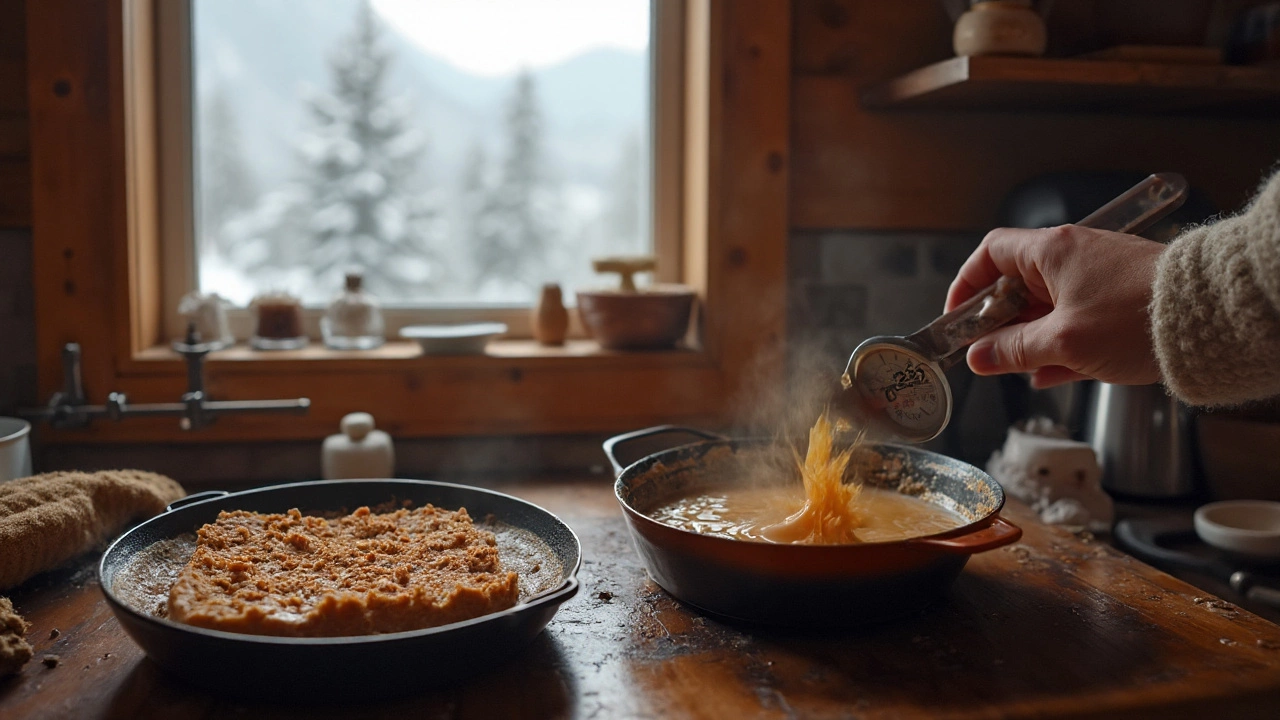
Variations, Altitude, and When Temps Change
Not every fudge recipe cooks the same way. Here’s where the target temperature stays the same-and where it shifts.
Classic “old-fashioned” fudge
This is the sugar-syrup style with milk/cream and butter, cooked to soft-ball stage. Chocolate fudge, brown sugar fudge, and maple fudge in this style all use the same 234-240°F (112-116°C) target. The chocolate type sometimes feels more forgiving because cocoa solids help interrupt crystal growth, which is why it can seem less fussy than plain vanilla.
Condensed milk “quick” fudge
Many modern “two-ingredient” fudges use condensed milk and chocolate. These don’t rely on a sugar stage at all. You melt, mix, and set. Temperature here is more about not scorching chocolate. Bring just to a gentle melt (about 113-122°F / 45-50°C) and stir until smooth. If you’re making this style, ignore the soft-ball target; it doesn’t apply.
White chocolate and blond fudges
White chocolate has milk solids and cocoa butter but no cocoa solids, so it scorches easily and can seize if water splashes in. If it’s a classic cooked fudge with sugar syrup, you still aim for soft-ball stage. If it’s a condensed-milk version, keep the heat very low and melt gently.
Altitude adjustments that actually work
Water boils at a lower temperature at higher elevations, which means your syrup reaches the “right concentration” at a lower reading on your thermometer. Do this once and your fudge will improve overnight:
- Boil water and note the reading. Say your water boils at 209°F instead of 212°F. That’s 3°F lower.
- Subtract that difference from your fudge target. If you normally aim for 237°F, aim for 234°F instead.
- Metric version: if your water boils at 98.5°C instead of 100°C, the difference is 1.5°C. Subtract 1.5°C from your target (say, 114°C becomes 112.5°C).
Induction hobs and gas vs electric
Induction changes heat fast, which is great for control, but it can cause sudden boiling spikes. Keep the heat medium and steady. With gas, watch for hot spots and rotate the pan. Electric coils tend to hold heat; pull the pan off heat a touch earlier if you notice momentum pushing the temp up after you turn it off.
Texture tuning: how to get it softer or firmer on purpose
- Softer slice: stop at 234-236°F (112-113°C).
- Classic slice: aim for 237°F (114°C).
- Firm gift-box squares: 238-240°F (114-116°C).
- Richer mouthfeel: add 10-15% more butter after cooking, before beating.
Why beating temperature matters
When the syrup cools to around 43-49°C (110-120°F), its viscosity and supersaturation encourage many small crystals instead of a few large ones. This is standard practice in professional kitchens (you’ll see the same cue in pastry texts and training manuals). If you beat too hot, the crystals grow coarse and the texture turns sandy. If you wait too long and it’s too cool, it may set in the pot.
Checklist, Table, Mini‑FAQ and Fixes
Pre-cook checklist
- Thermometer tested in boiling water (calibrated)?
- Heavy pan chosen, sides high enough to prevent boil-overs?
- Sugar fully dissolved before boiling?
- Pastry brush and water ready to wash down stray crystals?
- Baking tin lined and waiting?
During-cook checklist
- Heat steady, not on full blast?
- No stirring after a full boil begins?
- Thermometer tip not touching the bottom?
- Target temp chosen (soft, classic, or firm)?
- Cold-water test done if in doubt?
After-cook checklist
- Do not scrape the sides or bottom when pouring.
- Cool undisturbed to 110-120°F (43-49°C) before beating.
- Beat just until the gloss goes and the mixture thickens.
- Pour and level quickly; it sets fast once ready.
Sugar stages at a glance
| Sugar Stage | °F | °C | What It Looks Like in Cold Water | Typical Uses |
|---|---|---|---|---|
| Thread | 215-234 | 102-112 | Thin threads | Simple syrups, glazes |
| Soft-ball | 234-240 | 112-116 | Soft, pliable ball | Fudge, fondant |
| Firm-ball | 242-248 | 117-120 | Firmer ball that holds shape | Caramels (chewy) |
| Hard-ball | 250-266 | 121-130 | Harder ball | Nougat, marshmallows |
| Soft-crack | 270-290 | 132-143 | Bendy threads | Toffees |
| Hard-crack | 295-309 | 146-154 | Snaps cleanly | Brittle, lollipops |
Mini‑FAQ
- What temperature should I cook fudge to? 234-240°F (112-116°C). Many cooks aim for 237°F (114°C) for a balanced set.
- How do I adjust for altitude? Find your boiling point of water. Subtract the difference from 212°F (100°C) from your target. Example: boil at 209°F? Target 237°F becomes 234°F.
- Can I make fudge without a thermometer? Yes. Use the cold-water test and the visual cues (soft ball that flattens when pressed). Still, a thermometer makes it easier.
- When do I start beating? After it cools to 110-120°F (43-49°C). Beat until it loses shine and thickens.
- Why is my fudge grainy? Usually seeded crystals: stirring after boiling started, sugar on the pan sides, or beating too hot. Dissolve sugar fully next time and avoid scraping the pan.
- Why didn’t my fudge set? It likely didn’t reach soft-ball stage. You can reheat with a splash of water, bring back to a boil, and cook to the correct temp.
- Why is it too hard? Cooked too hot or too long. Next time, stop a degree or two lower. You can sometimes rescue by breaking it up, adding a little milk/cream, and recooking to a lower temp.
- Does recipe style change the target? Old-fashioned fudge: yes, soft-ball stage. Condensed milk fudge: no; melt and mix, don’t cook to a stage.
- Butter salted or unsalted? Unsalted gives you control. Add a pinch of fine salt to taste.
- Do I need corn syrup or glucose? A little can help prevent crystallisation, but you can make great fudge without it if you dissolve sugar well and avoid seeding crystals.
Real-world fixes
- Too soft and won’t slice: Return the fudge to the pan with 2-3 tablespoons of water per 500 g batch. Dissolve, boil without stirring, and recook to the correct temperature. Cool and beat again.
- Too firm and dry: Crumble it, add milk/cream (1-2 tablespoons at a time), gently reheat to dissolve, and stop at a lower target temperature. Add a little extra butter when beating to soften the texture.
- Grainy texture: Next time, wash down pan sides during early heating, avoid stirring during the boil, and don’t scrape the pan when you pour. Beat only at 110-120°F (43-49°C).
- Glossy but won’t set: You probably didn’t beat long enough at the right temp. Beat a bit more until it loses its sheen and thickens, then pour immediately.
- Scorched bottom: Use a heavier pan, slightly lower heat, and avoid high heat at the start. Stir only until sugar dissolves, then stop.
Evidence and sources
The soft-ball range given here (234-240°F / 112-116°C) aligns with the USDA’s candy-making guidance and is the same range taught in professional kitchens (Culinary Institute of America, The Professional Chef). The cooling and beating range (about 43-49°C / 110-120°F) reflects standard pastry practice and the crystallisation principles described by Harold McGee in “On Food and Cooking.”
A quick decision path
- Making old-fashioned fudge? Shoot for 237°F (114°C), adjusted for altitude.
- Want softer? Stop at 234-236°F (112-113°C).
- Want firmer? Stop at 238-240°F (114-116°C).
- No thermometer? Cold-water test to soft ball and watch the visual cues.
- Live at altitude? Subtract the boiling-point difference from your target.
Hit that temperature and you’re most of the way there. Let it cool to the right beating window, stop when it loses gloss, and you’ll get that smooth, creamy fudge snap that slices clean and melts in the mouth.

